How Advertising and Public Relations Agencies Utilize Design Thinking in Everyday Business
In the fast-paced world of advertising and public relations, agencies are constantly seeking innovative strategies to keep ahead of rapidly changing consumer trends and digital landscapes. One approach that has proven incredibly effective is design thinking—a methodology not traditionally associated with advertising but now at the forefront of creative strategy. This article explores how advertising and public relations agencies are integrating design thinking into their everyday business to deliver groundbreaking campaigns and forge deeper connections with audiences.
Understanding Design Thinking
Design thinking is a human-centered approach to innovation that integrates the needs of people, the possibilities of technology, and the requirements for business success. It involves five key stages: empathize, define, ideate, prototype, and test. By empathizing with users, defining problems, ideating solutions, prototyping, and testing, agencies can develop more innovative, effective, and user-friendly solutions.
Application in Advertising and Public Relations
1. Empathize with the Audience: The first step in design thinking is understanding the audience's needs and experiences. Advertising and PR agencies utilize this stage to dive deep into consumer behavior and emotions. Through focus groups, surveys, and social media listening, agencies gather insights that help tailor messages and campaigns that resonate on a personal level.
2. Define the Challenge: Once the audience's needs are understood, agencies define the specific challenges to be addressed. This might involve crafting a brand message that stands out in a crowded market or finding an innovative way to tackle a public relations crisis. The definition phase helps agencies focus their efforts and resources on what matters most.
3. Ideate Creative Solutions: With a clear challenge in focus, agencies brainstorm a wide range of creative solutions. This stage encourages thinking outside the box and considering ideas that might initially seem far-fetched. It's all about pushing boundaries and coming up with innovative concepts that capture attention and engage audiences.
4. Prototype and Test Ideas: Before launching a full-scale campaign, agencies prototype. This could be anything from mock-ups of advertising materials to beta versions of digital campaigns. These prototypes are then tested with target audiences to gather feedback. This iterative process ensures that the final product is as effective and engaging as possible.
5. Implement and Learn: The final step is to implement the campaign and continue learning from its performance. Agencies monitor metrics and gather data to see what works and what doesn’t, allowing for real-time adjustments and improvements. This continuous loop of feedback and refinement is crucial for staying relevant and impactful.
The Benefits of Design Thinking in Advertising and PR
By adopting design thinking, agencies can achieve several benefits:
Increased Creativity: Design thinking encourages creative problem-solving, leading to more innovative and engaging campaigns.
Greater Audience Engagement: By focusing on the needs and experiences of the audience, agencies can create campaigns that resonate more deeply with consumers.
Enhanced Collaboration: Design thinking fosters collaboration across different teams and departments, breaking down silos and integrating diverse perspectives.
Agility and Flexibility: The iterative nature of design thinking allows agencies to be more agile and adapt to changes quickly, an invaluable trait in the dynamic advertising and PR landscape.
Conclusion
As the advertising and public relations sectors continue to evolve, the application of design thinking offers a powerful framework for innovation. By placing human needs at the center of their creative processes, agencies can craft campaigns that not only capture attention but also connect with audiences on a meaningful level. In the quest to stand out in a saturated market, design thinking is no longer just a methodology—it's a necessity.
